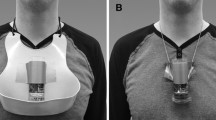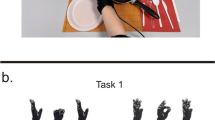Abstract
The present study aimed at verifying whether and why sequences of actions directed to oneself are facilitated when compared to action sequences directed to conspecifics. In experiment 1, participants reached to grasp and brought a piece of food either to their own mouth for self-feeding or to the mouth of a conspecific for feeding. In control conditions, they executed the same sequence to place the piece of food into a mouth-like aperture in a flat container placed upon either their own mouth or the mouth of a conspecific. Kinematic analysis showed that the actions of reaching and bringing were faster when directed to the participant’s own body, especially for self-feeding. The data support the hypothesis that reaching to grasp and bringing to one’s own body and, in particular, one’s own mouth for self-feeding, form an automatic sequence, because this is the result of more frequent execution and coordination between different effectors of one’s own body, such as arm and mouth. In contrast, the same sequence directed toward a conspecific is not automatic and requires more accuracy probably because it is guided by social intentions. This hypothesis was supported by the results of control experiment 2 in which we compared the kinematics of reaching to grasp and placing the piece of food into the mouth of a conspecific (i.e. feeding) with those of reaching to grasp and placing the same piece of food into a mouth-like aperture in a human body shape (i.e. placing). Indeed, the entire sequence was slowed down during feeding when compared to placing.



Similar content being viewed by others
References
Becchio C, Sartori L, Bulgheroni M, Castiello U (2008) The case of Dr. Jekyll and Mr. Hyde: a kinematic study on social intention. Conscious Cogn 17:557–564
Cattaneo L, Fabbri-Destro M, Boria S, Pieraccini C, Monti A, Cossu G, Rizzolatti G (2007) Impairment of actions chains in autism and its possible role in intention understanding. Proc Natl Acad Sci USA 104:17825–17830
Fitts PM (1954) The information capacity of the human motor system in controlling the amplitude of movement. J Exp Psychol 47:381–391
Fogassi L, Ferrari PF, Gesierich B, Rozzi S, Chersi F, Rizzolatti G (2005) Parietal lobe: from action organization to intention understanding. Science 308:662–667
Gallagher S, Butterworth G, Lew A, Cole J (1998) Hand–mouth coordination, congenital absence of limb, and evidence for innate body schemas. Brain Cogn 38:53–65
Gentilucci M, Fogassi L, Luppino G, Matelli M, Camarda R, Rizzolatti G (1988) Functional organization of inferior area 6 in the macaque monkey. I. Somatotopy and control of proximal movements. Exp Brain Res 71:475–490
Gentilucci M, Negrotti A, Gangitano M (1997) Planning an action. Exp Brain Res 115:116–128
Graziano MS, Taylor CS, Moore T, Cooke DF (2002) The cortical control of movement revisited. Neuron 36:349–362
Jeannerod M (1988) The neural and behavioural organization of goal-directed movements. Clarendon Press, Oxford
Johnson-Frey SH, McCarty ME, Keen R (2004) Reaching beyond spatial perception: effects of intended future actions on visually guided prehension. Vis Cogn 11:371–399
Lew A, Butterworth G (1997) The development of hand-mouth coordination in 2- to 5-month-old infants: similarities with reaching and grasping. Infant Behav Dev 20:59–69
Marteniuk RG, MacKenzie CI, Jeannerod M, Athens S, Dugas C (1987) Constraints on human arm movement trajectories. Can J Psychol 41:365–378
Mason AH, Mackenzie CL (2005) Grip forces when passing an object to a partner. Exp Brain Res 163:173–187
Meulenbroek RG, Bosga J, Hulstijn M, Miedl S (2007) Joint-action coordination in transferring objects. Exp Brain Res 180:333–343
Oldfield RC (1971) The assessment and analysis of handedness: the Edinburgh inventory. Neuropsychologia 9:97–113
Rizzolatti G, Scandolara C, Matelli M, Gentilucci M (1981a) Afferent properties of periarcuate neurons in macaque monkeys. I. Somatosensory responses. Behav Brain Res 2:125–146
Rizzolatti G, Scandolara C, Matelli M, Gentilucci M (1981b) Afferent properties of periarcuate neurons in macaque monkeys. II. Visual responses. Behav Brain Res 2:147–163
Rochat P (2001) The infant’s world. Harvard University Press, London
Rosenbaum DA, Jorgensen MJ (1992) Planning macroscopic aspects of manual control. Hum Mov Sci 11:61–69
Sartori L, Becchio C, Bulgheroni M, Castiello U (2009) Modulation of the action control system by social intention: unexpected social requests override preplanned action. J Exp Psychol Hum Percept Perform 35:1490–1500
Takeshita H, Myowa-Yamakoshi M, Hirata S (2005) A new comparative perspective on prenatal motor behaviors: preliminary research with four-dimensional ultrasonography. In: Matsuzawa T, Tomonaga M, Tanaka M (eds) Cognitive development in chimpanzees. Springer, Tokyo, pp 37–47
Tsakiris M, Schutz-Bosbach S, Gallagher S (2007) On agency and body-ownership: phenomenological and neurocognitive reflections. Conscious Cogn 16:645–660
Zoia S, Blason L, D’ Ottavio G, Bulgheroni M, Pezzetta E, Scabar A, Castiello U (2007) Evidence of early development of action planning in the human foetus: a kinematic study. Exp Brain Res 176:217–226
Acknowledgments
We thank Filippo Barbieri and Nicolò Bernardi for their help in carrying out experiment 1, and Patricia Gough for her comments on the manuscript. The work was supported by grants from MIUR (Ministero dell’Istruzione, dell’Università e della Ricerca) to M.G.
Author information
Authors and Affiliations
Corresponding author
Rights and permissions
About this article
Cite this article
Ferri, F., Campione, G.C., Dalla Volta, R. et al. To me or to you? When the self is advantaged. Exp Brain Res 203, 637–646 (2010). https://doi.org/10.1007/s00221-010-2271-x
Received:
Accepted:
Published:
Issue Date:
DOI: https://doi.org/10.1007/s00221-010-2271-x




